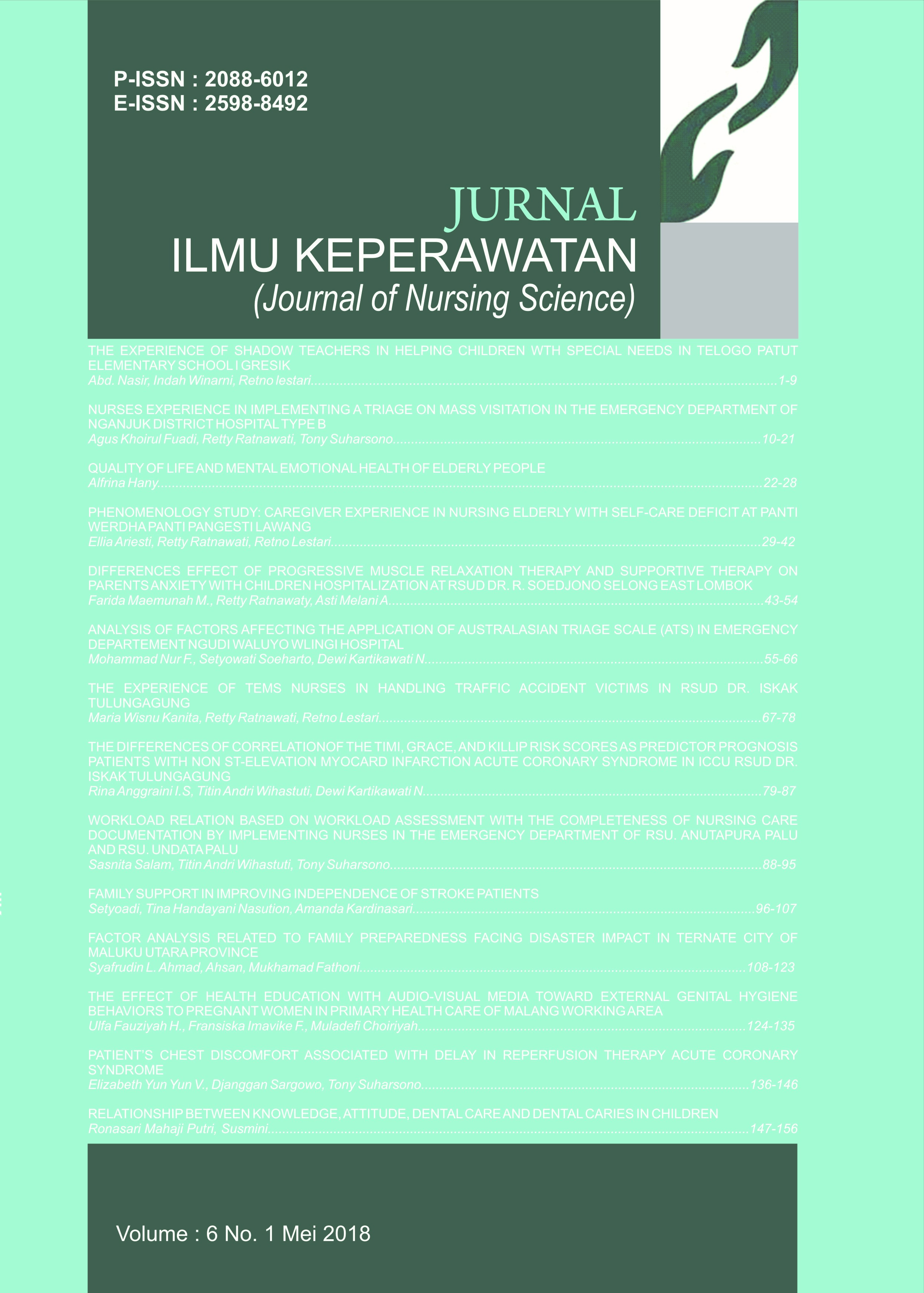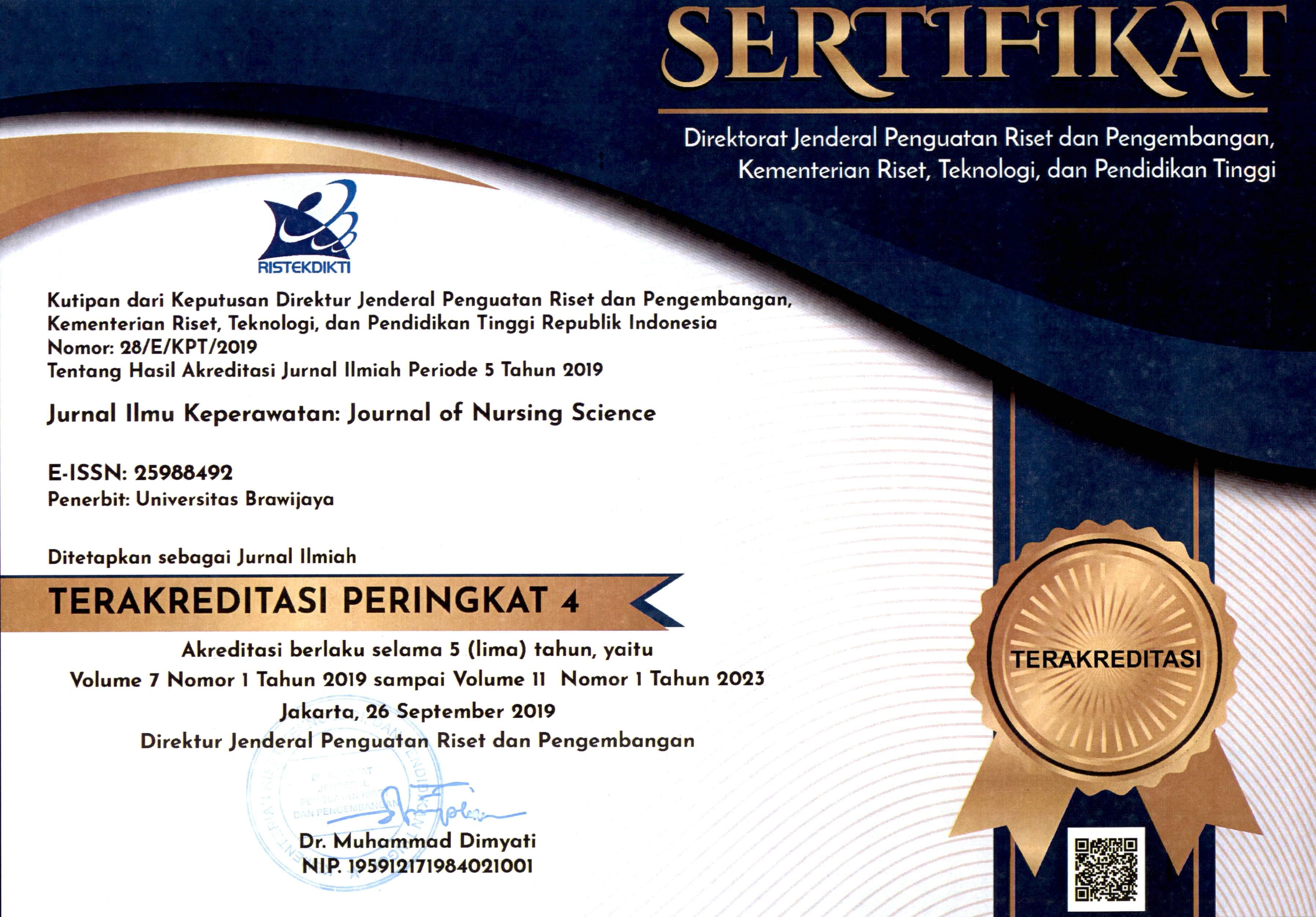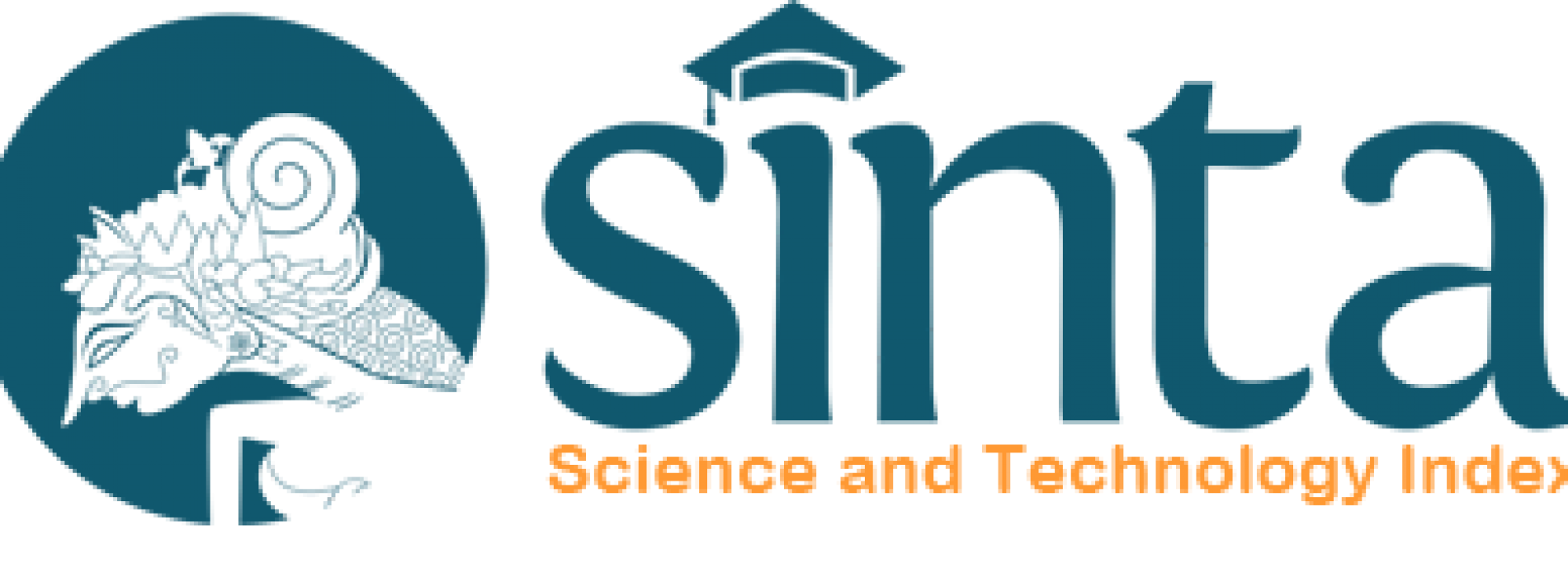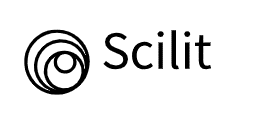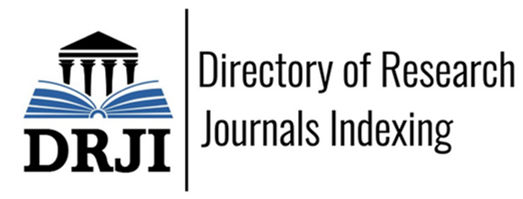FACTORIAL ANALYSIS RELATED TO FAMILY PREPAREDNESS FACING DISASTER IMPACT IN TERNATE CITY OF MALUKU UTARA PROVINCE
DOI:
https://doi.org/10.21776/ub.jik.2018.006.01.11Keywords:
Knowledge, attitude, social capital, family preparednessAbstract
Disasters occur when vulnerable people are faced with threats that they are unable to cope with or have low capacity to overcome them. Preparedness is the most critical phase in the range of disaster management, the inadequacy of disaster preparedness planning has created the suffering of survivors and loss of life. The purpose of this study was to analyze factors related to family preparedness in Ternate city. This research use descriptive analytic design with Cross sectional study approach. Respondents in this study were 113 Head of Family (KK) by using systematic random sampling. Chi-square test shows the related relationship (p = 0,005), attitude (p = 0.000) and social capital (p = 0.000) to risky family preparedness in Ternate city. The result of logistic regression test shows that social capital has the strongest strength of relationship (p = 0,022, OR = 2,725) compared to attitude (p = 0,025, OR = 2,680) and knowledge (p = 0,041, OR = 2,520). His result shows that good knowledge, attitude and social capital will increase the family preparedness in the face of disaster impact in Ternate City.
References
- Adlina, N., Agussabti., & Hermansyah. (2014). Kesiapsiagaan Masyarakat dalam Menghadapi Situasi Bencanagunung Api Seulawah Agam Di Wilayah Kecamatan Saree Kabupatenaceh Besar. Jurnal Ilmu Kebencanaan. Vol:1 (1): 17- 25.
- Asnayanti., Kumaat, L & Wowiling, F. (2013). Hubungan Mekanisme Koping dengan Kejadian Stres Pasca Bencana Alam pada Masyarakat Kelurahan Tubo Kota Ternate. EJournal keperawatan (e-Kp). Vol. 1 (1).
- Azwar. (2010). Teori dan pengukuran pengetahuan, sikap dan perilaku manusia. Yogyakarta. Nuha Medika.
- Badan Penanggulangan Bencana Daerah (BPBD) Kota Ternate. (2012). Dokumen kajian risiko bencana Kota Ternate Propinsi Maluku Utara 2013-2017. Ternate.
- Badan Pusat Statistik (BPS) Kota Ternate. (2016). Data Kependudukan Kota Ternate tahun 2015. Diakses tanggal 7 Februari 2017, dari https://ternatekota.bps.go.id/Subjek/view/id/12#subjekViewTab3|accordion-daftar-subjek1
- Baker, L. R & Cormier, L. A. (2013). Disaster preparedness and families of children with special needs: A geographic comparison. Journal of Community Health Vol.38 (1):106-112.
- Bourque, L. B. (2013). Household preparedness and mitigation. International Journal of Mass Emergencies and Disasters, Vol. 31(3):360-372.
- Central Disaster Management Council (CDMC). (2011). Basic Disaster Management Plan. Diakses tanggal 2 Februari 2017, dari http://www.bousai.go.jp/keikaku/20111227_basic_plan.pdf.
- Chan, E. Y. Y., Kim, J. H., Lin, C., Cheung, E. Y. L & Lee, P. P. Y. (2012). Is Previous Disaster Experience a Good Predictor for Disaster Preparedness in Extreme Poverty Households in Remote Muslim Minority Based Community in China. J Immigrant Minority Health. 16:466–472.
- Dantzler, D. (2013). Basic household disaster preparedness decisional Influences among male federal employees in the national Capital region. Dissertation Doctor of Philosophy Capella University. ProQuest LLC. UMI Number:3559889.
- Data dan Informasi Bencana Indinesia (DIBI). (2017). Data Kejadian Bencana Indonesia. Diakses tanggal 2 Februari dari http://dibi.bnpb.go.id/data-bencana.
- Elliott, J., H, T & Sams-Abiodun, P. (2010). Limits to social capital: Comparing network assistance in two New Orleans neighbors devastated by Hurricane Katrina. Sociological Quarterly, 51: 624-648
- Gregory, G. (2015). Persuading the public to make better use of natural hazard information. Prometheus. 13(1), 61-71
- Groves, S. (2013). Knowledge, Involvement and Emergency Preparedness. Thesis Master of Arts School of Mass Communications College of Arts and Sciences University of South Florida. ProQuest LLC. UMI Number: 1543119
- Handicap International. (2014). Inclusive Household Disaster Preparedness Workbook. Philippines. Handicap International.
- Hawkins, R. L., & Maurer, K. (2010). Bonding, bridging and linking: how social capital operated in New Orleans following Hurricane Katrina. British Journal of Social Work. 40, 1777-1793.
- International Council of Nurse (ICN) & World Health Organization (WHO). (2009). ICN Framework of Disaster Nursing Competencie. WHO/WPRO. Geneva.
- Kano, W., Mileti, D & Bourque, L. (2011). Re-conceptualizing household disaster readiness: The get ready pyramid. Journal of Emergency Management. 7:25-37
- Kim, Y. C., & Kang, J. (2010). Communication, neighbourhood belonging and household hurricane preparedness. Disasters. 34(2):470-488
- Levac, J., Toal-Sullivan, D., & O’Sullivan, T. L. (2012). Household Emergency Preparedness: A Literature Review. Journal of Community Health, 37(3):725-733.
- Meyer, M. A. (2013). Social capital and collective efficacy for disaster resilience: Connecting individuals with communities and vulnerability with resilience in hurricane-prone communities in Florida. Colorado State University.
- Mizam, A. K, (2012). Peran Tenaga Kesehatan dalam Penanganan Bencana. Jurnal Ilmiah Kesehatan Media Husada. 1(1).
- Mulilis, J. P., Duval, T. S., & Bovalino, K. (2012). Tornado preparedness of students, nonstudents renters, and non-student owners: Issues of PrE theory. Journal of Applied Social Psychology, 30(6), 1310-1329.
- Murphy, S. T., Cody, M., Frank, L. B., Glik, D., & Ang, A. (2009). Predictors of Emergeny Preparedness and Compliance. Disaster Medicine and Public Health Preparedness. 3:1-10.
- Nakagawa, Y & Shaw, R. (2014). “Social Capital: A Missing Link to Disaster Recovery.†International Journal of Mass Emergencies and Disasters 22(1): 5-34.
- Neal, D. M., Perry, J. B. Jr. & Hawkins, R. (2012). Getting ready for blizzards: Preparation levels in the winter of 1977-1978. Sociological Focus, 15 (1), 67-76.
- Nugroho. (2015). Preparedness Assessment Tools For Indonesia. Jakarta: Humanitarian Forum Indonesia & MDM.
- Notoatmodjo, S. (2012). Promosi Kesehatan dan Perilaku Kesehatan. Jakarta. Rineka Cipta
- Pusponegoro, A. D & Sujudi, A. (2016). Kegawatdaruratan dan bencana: solusi dan petunjuk teknis penanggulangan medik dan kesehatan. Ed.1. Jakarta. Rayyana Komunikasindo.
- Reininger, B. M., Rahbar, M. H., Lee, M., Chen, Z., Pope, J. & Adams, B. (2013). Social capital and disaster preparedness among low income Mexican Americans in a disaster prone area, Journal Social Science & Medicine.Vol:8(3): 50-60.
- Rokeach, S. J. (2016). Community storytelling network, neighborhood context, and neighborhood engagement: A multilevel analysis. Human Communication Research, 32(3), 411-439.
- Samuda, S. (2016). Barifola Sebagai Modal Sosial dan Instrumentasi Masyarakat Tangguh Bencana. Jurnal Penelitian Humaniora, Vol:21 (2): 109-118
- Sumaiya, S.. Mohamad, M. S., Reza, M. I. H., Manap, J & Sarkar, Md. S. K. (2015). Social Capital And Disaster Preparedness: Conceptual Framework And Linkage. Journal of the Social Science Researches. Vol:3-2015. 38-48.
- Thomas, T. N., Leander-Griffith, M., Victoria H.; Joan, P & Cioffi. (2015). Influences of preparedness knowledge and beliefs on household disaster preparedness. Morbidity and Mortality Weekly Report. 64(35):965-971
- Tomio, J., Sato, H., Matsuda, Y., Koga, T & Mizumura, H. (2014). Household and Community Disaster Preparedness in Japanese Provincial City: A Population-Based Household Survey. Advances in Anthropology, 4:68-77.
- Triutomo,S., Wisnu, B., & Widjaja, R. S.(2015). Perencanaan Kontijensi Menghadapi Bencana. ed 2. Jakarta: BNPB.
- Tse, C. W., Wei, J., & Wang, Y. (2013). Social capital and disaster recovery: Evidence from Sichuan earthquake in 2008. Washington, DC: Center for Global Development.
- Tuhusetya, S. (2012). Pendidikan kebencanaan dan kesigapan mengurangi risiko. Diakses dari http://sawali.com tanggal 9 Agustus 2017.
- United Nations International Strategy for Disaster Reduction (UNSDR). (2014). Terminology on disaster risk reduction. Di akses tanggal 2 Februari 2017, dari http://www.unisdr.org/who-weare/what-is-drr.
- United States Agency for International Development. (USAID). (2013). Early warning, preparedness, mitigation, and prevention. Diakses tanggal 2 Februari 2017, dari http://www.usaid.gov/what-we-do/working-crises-and-conflict/disaster-risk-reduction-0/early-warning-preparedness.
- Varda., Danielle., Forgette, R., Banks, D & Noshir Contractor. (2016). “Social Network Methodology in the Study of Disasters: Issues and Insights Prompted by Post-Katrina Research.†Population Research and Policy Review. Vol:28(1): 11-29.
- Widyaningrum, D. (2016). Modal sosial inklusif dalam jaringan Komunikasi bencana. Jurnal ASPIKOM, Vol; 3: 1.
- Word Health Organisation (WHO). (2007). Risk reduction and emergency preparedness: WHO six-year strategy for the health sector and community capacity development, Geneva Switzerland . WHO Press.
Published
How to Cite
License
Authors published in this journal agree to the following terms:
1. The copyright of the received article shall be assigned to the journal as the publisher of the journal. The intended copyright includes the right to publish the article in various forms (including reprints). The journal maintains the publishing rights to the published articles.
2. Authors may enter into separate additional contractual agreements for the non-exclusive distribution of the published journal version of the work (for example, posting it to an institutional repository or publishing it in a book), with acknowledgment of their initial publication in this journal.
3. Authors are permitted and encouraged to post their work online (e.g. in an Institutional Repository or on their website) before and during the submission process, as this can result in a productive exchange, as well as earlier and larger citations of the published work.
4. Articles and all related material published are distributed under Creative Commons Attribution-NonCommercial 4.0 International License or CC BY-NC 4.0 license.
JNSU is licensed under a Creative Commons Attribution-NonCommercial 4.0 International License or CC BY-NC 4.0 license.
Most read articles by the same author(s)
- Marsaid Marsaid, M Hidayat, Ahsan Ahsan, FAKTOR YANG BERHUBUNGAN DENGAN KEJADIAN KECELAKAAN LALU LINTAS PADA PENGENDARA SEPEDA MOTOR DI WILAYAH POLRES KABUPATEN MALANG , Journal of Nursing Science Update (JNSU): Vol. 1 No. 2 (2013)
- Setyoadi Setyoadi, Ahsan Ahsan, Alif Yanur Abidin, HUBUNGAN PERAN KADER KESEHATAN DENGAN TINGKAT KUALITAS HIDUP LANJUT USIA , Journal of Nursing Science Update (JNSU): Vol. 1 No. 2 (2013)
- Rinik Eko Kapti, Ahsan Ahsan, Ana Istiqomah, PENGARUH BERMAIN DENGAN MEWARNAI TERHADAP PENURUNAN SKOR PERILAKU MALADAPTIF ANAK USIA PRASEKOLAH (3-5 TAHUN) YANG MENGALAMI HOSPITALISASI DI RUMAH SAKIT KABUPATEN KEDIRI , Journal of Nursing Science Update (JNSU): Vol. 1 No. 2 (2013)
- Moh. Ubaidillah Faqih, Ahsan Ahsan, Tina Handayani Nasution, ANALISIS FAKTOR YANG MEMPENGARUHI KEMANDIRIAN PADA PASIEN CEDERA KEPALA YANG PERNAH DIRAWAT DI IGD RSUD DR. R. KOESMA TUBAN , Journal of Nursing Science Update (JNSU): Vol. 5 No. 1 (2017)
- Aisyah Dzil Kamalah, Ahsan Ahsan, Heri Kristianto, EFEKTIVITAS PSIKOEDUKASI KELUARGA PADA CAREGIVER PASIEN ULKUS DIABETES MELITUS DALAM MENURUNKAN TINGKAT ANSIETAS , Journal of Nursing Science Update (JNSU): Vol. 4 No. 2 (2016)
- Yusron Amin, Ahsan Ahsan, Tony Suharsono, FACTOR ANALYSIS OF HYPOGLICEMIA LEVEL IN EMERGENCY DEPARTMENT OF BLAMBANGAN AND GENTENG GENERAL HOSPITAL BANYUWANGI , Journal of Nursing Science Update (JNSU): Vol. 5 No. 2 (2017)
- Ria Ramadhani Dwi Atmaja, Mohammad Hidayat, Mukhamad Fathoni, AN ANALYSIS OF CONTRIBUTING FACTORS IN NURSES’ ACCURACY WHILE CONDUCTING TRIAGE IN EMERGENCY ROOM , Journal of Nursing Science Update (JNSU): Vol. 8 No. 2 (2020)

